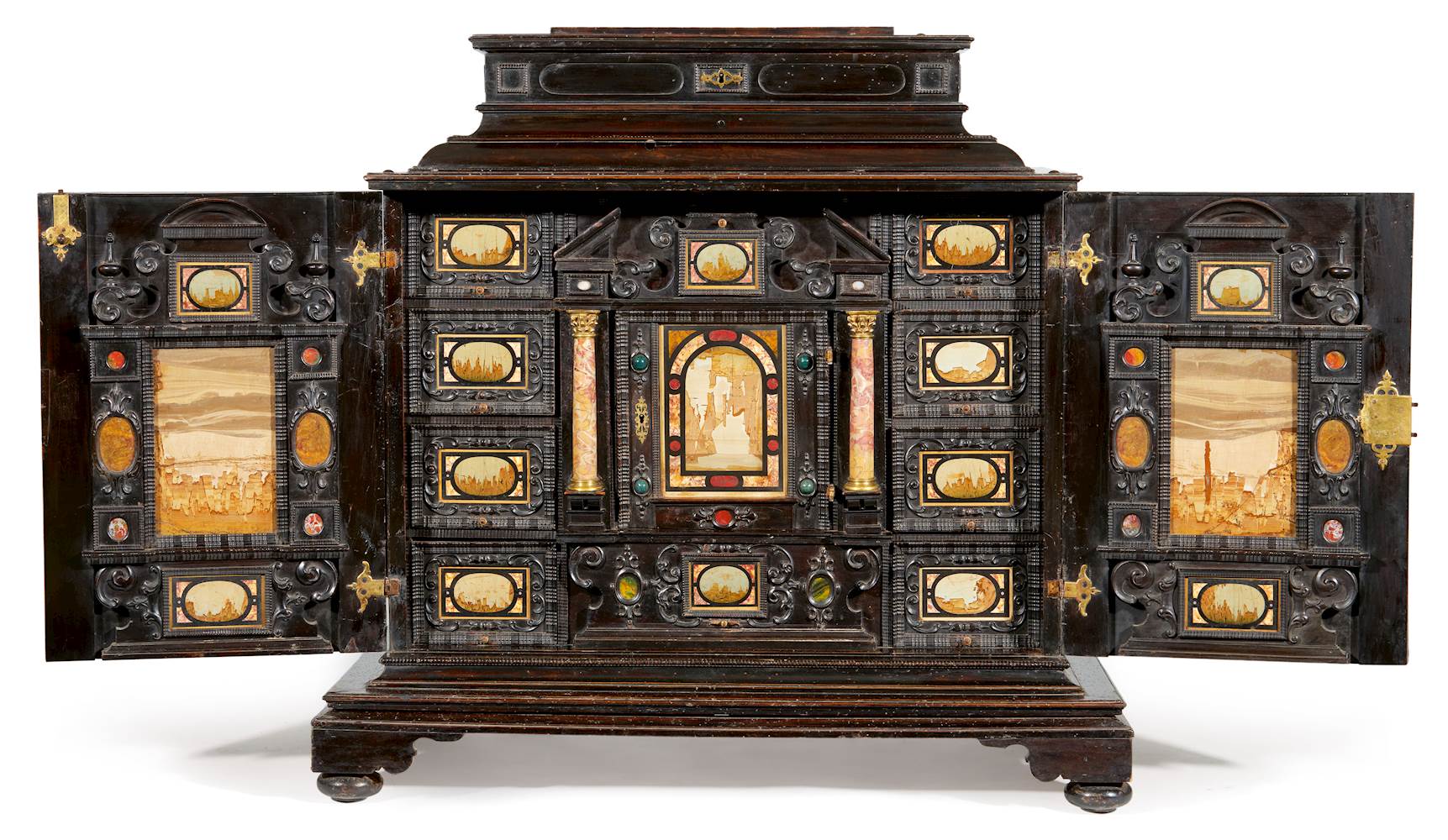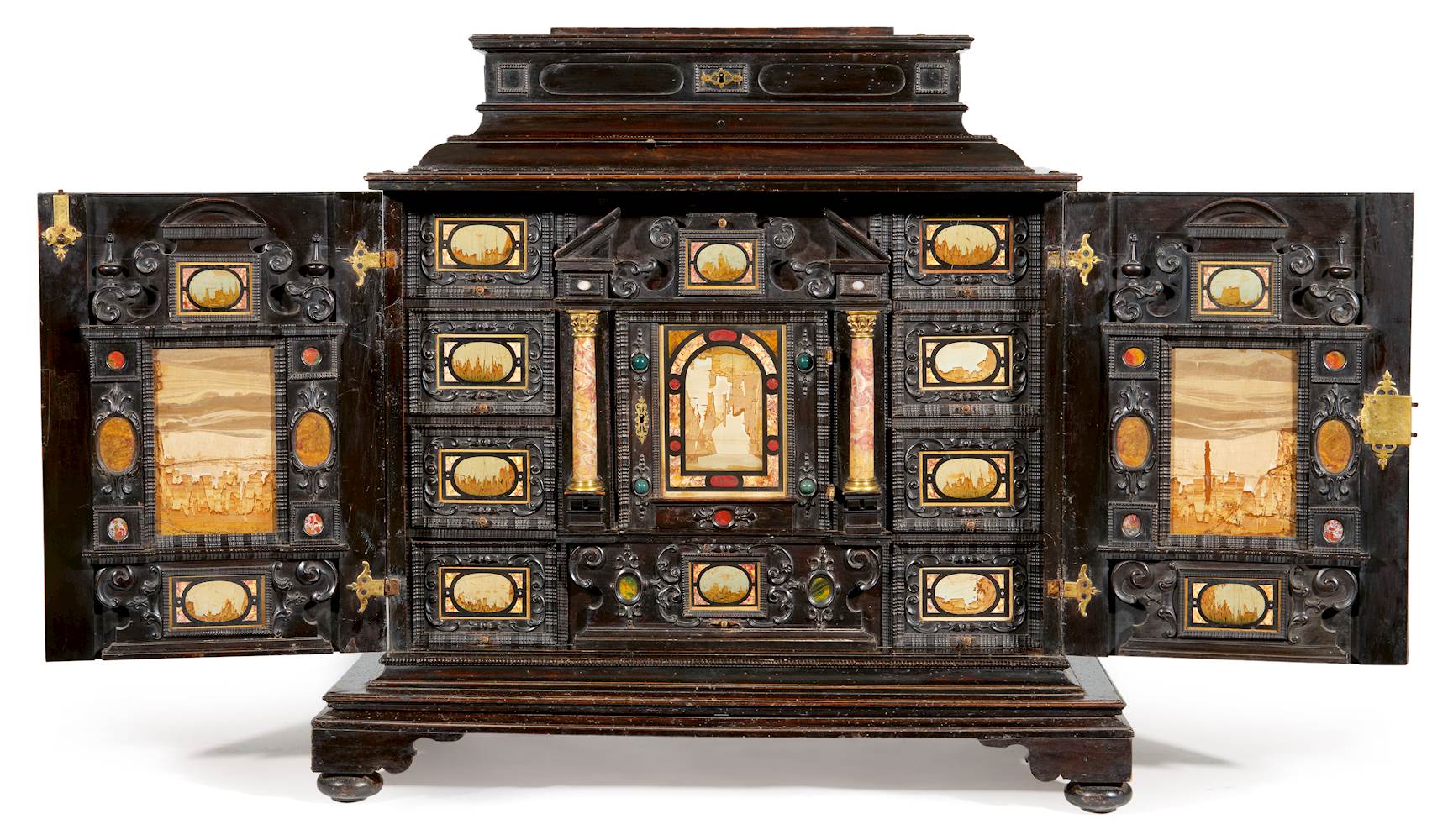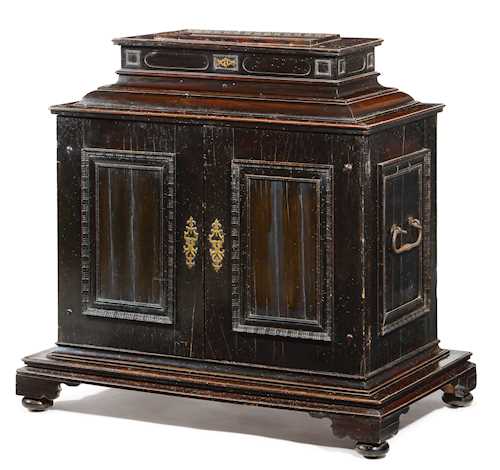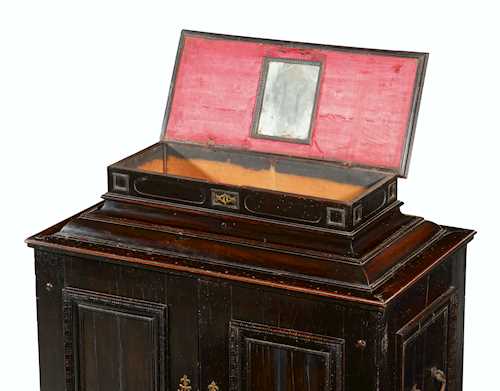
Lot 1032 - A210 Decorative Arts - Thursday, 19. September 2024, 02.00 PM
CABINET WITH “PIETRA DURA” AND “PIETRA PAESINA” INSERTS
Baroque, southern Germany or Bohemia, possibly Augsburg ca. 1640/50.
Ebonized fruitwood. Rectangular body, all sides with panels framed by flame moldings, on a straight cantilevered plinth with profiled edges. Iron handles on the sides. On an additional plinth with straight frame on corner consoles with flattened feet. Recessed and stepped top with hinged lid, the inside set with a small mirror. The double doors inside with an altar-shaped structure, inlaid with Pietra Paesina and various types of marble such as Broccatello di Spagna, Giallo antico, Nero del Belgio, Rosso antico, Diaspri di Sicilia, Bianchi in opale, Fior di Pesco in round or oval reserves. Architecturally structured interior with ten drawers arranged around a central door, flanked by marble half-columns. The half-columns are removable lids, each concealing five secret drawers. The door opens onto two drawers above a removable compartment in front of eight drawers. Decoration in the form of flame moldings and leaf volutes, pietra paesina and marble reserves as well as malachite cabochons. The inside of the drawers lined with red silk. Gilt and engraved fittings and handles. 3 keys.
90 × 59 × 88 cm.
Various cracks and losses. Filled wormholes. Doors somewhat warped. Pietra Paesina partly with cracks.
Provenance:
Private collection, Switzerland.
The origin of these cabinets is certainly to be found in Italy, but the type of furniture soon spread throughout Europe. Also known as art cabinets, they were an important part of courtly furniture and, due to their ornate design, formed part of art chambers themselves, where they were also used to store special collector's items.
Thanks to the numerous local artisans, the southern German city of Augsburg developed into a real center for the production of such cabinets in the 16th and 17th century. These were made of ebony or ebonized fruitwood and richly decorated with numerous geometric reserves using a wide variety of techniques and materials. Chased and engraved silver, tortoiseshell, ivory, semi-precious stones, pietra paesina or even still lifes or figurative depictions painted on copper are just a few examples.
The exterior of the furniture was often also richly decorated or remained relatively unadorned, as in this case (cf. a cabinet with a very similar exterior design in: Dieter Alfter: Die Geschichte des Augsburger Kabinettschranks. Augsburg 1986, fig. 81). The relatively plain exterior contrasts with the opulently decorated interior with its carvings, columns and various stone inlays in a rich architectural structure that also includes the inside of the doors. This suggests that the piece was conceived as an exhibit in an open state.
Augsburg works comparable in terms of design are illustrated in: Heinrich Kreisel: Die Kunst des deutschen Möbels. Munich 1968, vol. I, nos. 358, 361 and 363. Comparable works with stone inlays, in particular with pietra paesina, also known as ruined marble, are known not only from Italy but also from Bohemia. Cf. Kreisel 1968, no. 372.
Pietra Paesina panels, also known as Alberese, Dendritica or Lineato d'Arno, were originally a Florentine practice, an expression of a taste that had been particularly popular in Tuscany since the time of Cosimo II (1590-1621). The mysterious veins of this natural phenomenon stimulated curiosity about nature and the artistic sensibility of the late 16th century.
The various types of Pietra Paesina were usually cut into small slabs, which were then used in cabinets and caskets, but were sometimes inlaid with other stones or colored marble to form richer compositions to create table tops. Pietra Paesina was even used as a base for paintings, adding figures and other elements depending on the inspiration the stone offered the artist. This practice was very popular not only in Tuscany, but also in northern Europe and northern Italy.
Provenance:
Private collection, Switzerland.
The origin of these cabinets is certainly to be found in Italy, but the type of furniture soon spread throughout Europe. Also known as art cabinets, they were an important part of courtly furniture and, due to their ornate design, formed part of art chambers themselves, where they were also used to store special collector's items.
Thanks to the numerous local artisans, the southern German city of Augsburg developed into a real center for the production of such cabinets in the 16th and 17th century. These were made of ebony or ebonized fruitwood and richly decorated with numerous geometric reserves using a wide variety of techniques and materials. Chased and engraved silver, tortoiseshell, ivory, semi-precious stones, pietra paesina or even still lifes or figurative depictions painted on copper are just a few examples.
The exterior of the furniture was often also richly decorated or remained relatively unadorned, as in this case (cf. a cabinet with a very similar exterior design in: Dieter Alfter: Die Geschichte des Augsburger Kabinettschranks. Augsburg 1986, fig. 81). The relatively plain exterior contrasts with the opulently decorated interior with its carvings, columns and various stone inlays in a rich architectural structure that also includes the inside of the doors. This suggests that the piece was conceived as an exhibit in an open state.
Augsburg works comparable in terms of design are illustrated in: Heinrich Kreisel: Die Kunst des deutschen Möbels. Munich 1968, vol. I, nos. 358, 361 and 363. Comparable works with stone inlays, in particular with pietra paesina, also known as ruined marble, are known not only from Italy but also from Bohemia. Cf. Kreisel 1968, no. 372.
Pietra Paesina panels, also known as Alberese, Dendritica or Lineato d'Arno, were originally a Florentine practice, an expression of a taste that had been particularly popular in Tuscany since the time of Cosimo II (1590-1621). The mysterious veins of this natural phenomenon stimulated curiosity about nature and the artistic sensibility of the late 16th century.
The various types of Pietra Paesina were usually cut into small slabs, which were then used in cabinets and caskets, but were sometimes inlaid with other stones or colored marble to form richer compositions to create table tops. Pietra Paesina was even used as a base for paintings, adding figures and other elements depending on the inspiration the stone offered the artist. This practice was very popular not only in Tuscany, but also in northern Europe and northern Italy.
CHF 60 000 / 100 000 | (€ 61 860 / 103 090)








